Buying a wooden floor is a major purchase. With these 5 questions, you can be better prepared when buying a wood floor.
1. Where was the floor manufactured?
When buying a wood floor remember to ask not only where the wood comes from but also how and where it’s manufactured. Quality materials and construction will determine the longevity of your floor and these few simple questions could save you a major headache (if not a heart attack) in the long run.
Many of our WBP birch ply engineered boards not only possess great quality but also create the illusion of real, solid wood. With that in mind, it’s always good to ask not only the source of the wood but also where the boards are constructed. For example, not all engineered boards are suitable for underfloor heating due to cheaper substrates.
2. Is your floor in compliance with the EU safety standards?
All wood naturally contains levels of formaldehyde. The issue is the rate of release in parts per million. Our plywood is class E1 (0.1ppm) which is in complete compliance with EU safety standards. The UK allows for 2.0ppm as safe for use! (much higher).
Additionally, cheap overseas manufacturing sometimes uses softwood ply. This type of engineered board not only has higher concentrations of formaldehyde which are not only harmful to the environment but can also be harmful to personal health especially to those who are chemically sensitive.
In 2011, the National Toxicology Program from the US described this cheap adhesive as “known to be a human carcinogen” due to its high levels of toxicity. However, despite the well-documented adverse effects, many companies use cheap production processes to reduce the costs of their engineered wooden boards. els which enable us to create the finest oak floors available.
3. Is the plywood Water and Boil proof?
Underfloor Heating is a major factor when choosing a wood floor. Wood is a living material, it expands, shrinks and reacts to the environment. Using an engineered board is essential when fitting over underfloor heating but not all engineered boards are equal in quality and construction.
The best-engineered platform available on the market uses a high-quality European birch ply bonded with a natural, formaldehyde-free glue that is not only safe but WBP (water and boil proof) tested.
Overseas manufacturing commonly uses softwood ply. This type of cheaply produced engineered board is, in most cases, not suitable for underfloor heating.
4. Is the wood hard wax oiled?
In our humble opinion, the look of a hard waxed oiled wood floor is unrivalled, as is its tactile feel. A penetrating oil finish does not sit on the surface of the wood but rather sinks into the grain. Consequently, when you walk barefoot on an oil-finished floor, your feet are in direct contact with the wood. If you chose a surface treatment such as a Lacquer, on the other hand, there would always be a layer of plastic between you and the wood.
Lacquer is another solution, it looks good initially but only for a short time. A lacquered floor cannot be touched up locally but rather any damage requires the floor to be completely re-sanded and coloured again a costly and messy option. There are a few specialist water-based lacquers on the market that are marketed as lacquers that ‘behave like oils’, while this statement is impressive we are not confident that water can behave like oil.
Hard Wax Oils are the solution, this longer process will not only create beautiful results but will also protect the board for a longer time. This process produces a more organic and natural colour result and helps to maintain the overall health of the wood. The first coating creates the first bond and seals to the timber, then the second coat is applied to sit on top of the first coat for extra protection, this is why we rarely use ‘one coat systems’.
5. Is your installer fully qualified?
It’s an obvious concept and often forgotten. Any fine wood floor is only complete once it has been carefully installed, therefore we recommend that all of our floors are fitted by certified and experienced wood floor installers. The final grading and presentation of the floor become apparent in the final stages of the installation after numerous client meetings on site.







